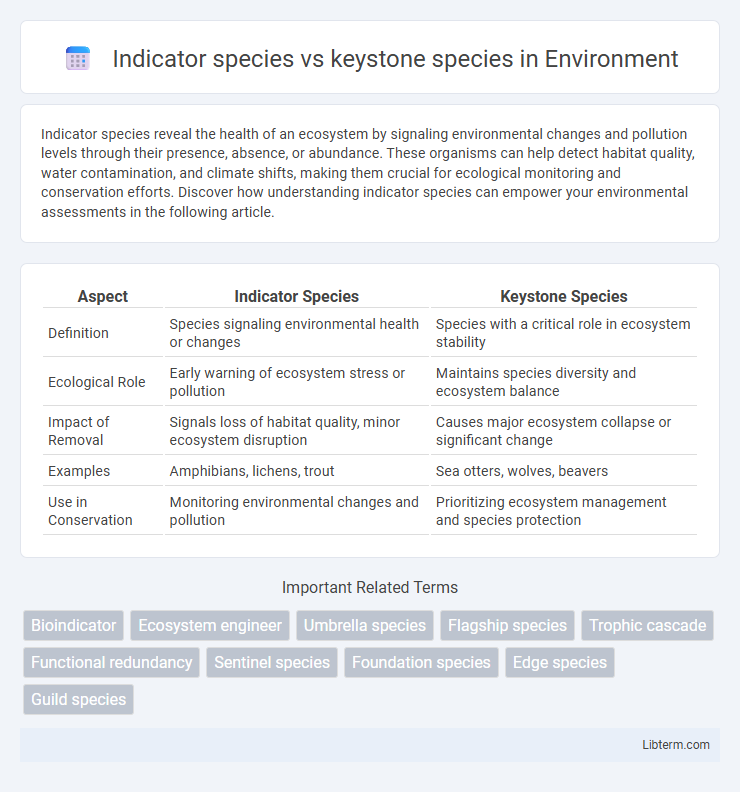Indicator species reveal the health of an ecosystem by signaling environmental changes and pollution levels through their presence, absence, or abundance. These organisms can help detect habitat quality, water contamination, and climate shifts, making them crucial for ecological monitoring and conservation efforts. Discover how understanding indicator species can empower your environmental assessments in the following article.
Table of Comparison
| Aspect | Indicator Species | Keystone Species |
|---|---|---|
| Definition | Species signaling environmental health or changes | Species with a critical role in ecosystem stability |
| Ecological Role | Early warning of ecosystem stress or pollution | Maintains species diversity and ecosystem balance |
| Impact of Removal | Signals loss of habitat quality, minor ecosystem disruption | Causes major ecosystem collapse or significant change |
| Examples | Amphibians, lichens, trout | Sea otters, wolves, beavers |
| Use in Conservation | Monitoring environmental changes and pollution | Prioritizing ecosystem management and species protection |
Introduction to Ecological Roles
Indicator species serve as natural markers reflecting the health and changes in specific ecosystems, providing valuable information about environmental conditions. Keystone species exert a disproportionate influence on ecosystem structure and function, often regulating populations and maintaining biodiversity despite their sometimes low abundance. Both roles are crucial for understanding ecosystem dynamics and guiding conservation efforts.
Defining Indicator Species
Indicator species are organisms whose presence, absence, or abundance reflects specific environmental conditions, serving as a measure of ecosystem health or changes. These species are sensitive to environmental stressors such as pollution, climate change, or habitat alteration, providing early warning signs of ecological imbalance. Unlike keystone species, which have a disproportionate impact on ecosystem structure, indicator species primarily function as biological monitors rather than ecosystem engineers.
Understanding Keystone Species
Keystone species play a critical role in maintaining the structure and balance of an ecosystem by exerting a disproportionate influence relative to their abundance, often through predation, ecosystem engineering, or species interactions. Unlike indicator species, which signal changes in environmental conditions, keystone species actively regulate community diversity and stability, such as sea otters controlling sea urchin populations to preserve kelp forests. Understanding keystone species helps ecologists identify crucial drivers of ecosystem health and develop targeted conservation strategies to protect biodiversity.
Key Differences: Indicator vs Keystone Species
Indicator species signal the health of an ecosystem by reflecting environmental changes, often sensitive to pollution or habitat alterations. Keystone species exert a disproportionate influence on ecosystem structure and function, maintaining biodiversity and ecological balance through their interactions. The key difference lies in their roles: indicator species serve as ecological barometers, while keystone species actively shape and sustain ecosystem dynamics.
Ecological Importance of Indicator Species
Indicator species serve as vital ecological barometers by reflecting the health and integrity of their environments, signaling changes in ecosystem conditions such as pollution, habitat loss, or climate shifts. Their presence, absence, or well-being provides early warnings that help scientists monitor biodiversity and ecosystem stability. Protecting indicator species aids in maintaining ecological balance and guiding conservation efforts for vulnerable habitats.
Ecosystem Impact of Keystone Species
Keystone species play a critical role in maintaining ecosystem stability by regulating population dynamics and promoting biodiversity, often disproportionate to their abundance. Their removal can trigger cascading effects that disrupt food webs and alter habitat structure, leading to significant ecological imbalance. Unlike indicator species that reflect environmental conditions, keystone species actively shape ecosystem processes through interactions with multiple species.
Examples of Indicator Species
Examples of indicator species include amphibians like the Northern Leopard Frog, which signal environmental health by their sensitivity to pollutants and habitat changes. Lichens serve as bioindicators of air quality since they absorb atmospheric contaminants and decline with increased pollution. Freshwater mussels also indicate water ecosystem health, as their presence or absence reflects changes in water quality and sedimentation.
Examples of Keystone Species
Keystone species are organisms that have a disproportionately large impact on their ecosystems relative to their abundance, such as sea otters, which control sea urchin populations, preventing overgrazing of kelp forests. Another example includes the African elephant, which shapes savanna and forest ecosystems by uprooting trees and creating clearings that promote biodiversity. Wolves in Yellowstone National Park serve as keystone predators by regulating prey populations and triggering trophic cascades that enhance ecosystem health.
Applications in Conservation and Management
Indicator species serve as biological gauges revealing ecosystem health, aiding conservationists in detecting environmental changes and pollution levels crucial for habitat protection policies. Keystone species, by maintaining ecosystem structure and function through their ecological roles, are targets for management efforts to preserve biodiversity and stabilize food webs. Utilizing both types guides adaptive conservation strategies, optimizing resource allocation for ecosystem resilience and restoration initiatives.
Choosing the Right Species for Ecosystem Monitoring
Indicator species, sensitive to environmental changes, provide early warnings about ecosystem health, making them essential for monitoring pollution, climate shifts, or habitat alterations. Keystone species exert significant influence on ecosystem structure and function, often regulating populations and maintaining biodiversity, which helps gauge broader ecological stability. Selecting the right species depends on monitoring objectives: indicator species offer specific responses to environmental stressors, while keystone species reflect the overall integrity and balance of the ecosystem.
Indicator species Infographic

 libterm.com
libterm.com